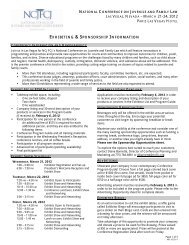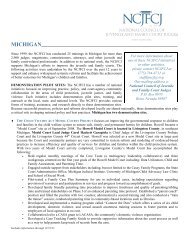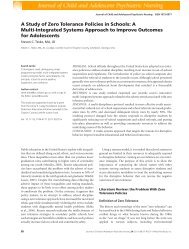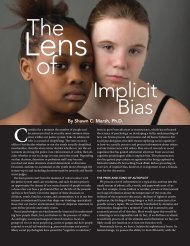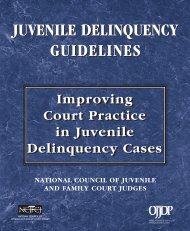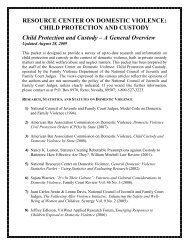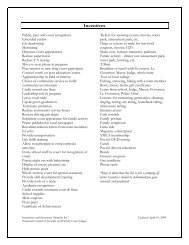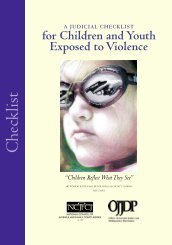The Marijuana Detection Window - National Drug Court Institute
The Marijuana Detection Window - National Drug Court Institute
The Marijuana Detection Window - National Drug Court Institute
- No tags were found...
Create successful ePaper yourself
Turn your PDF publications into a flip-book with our unique Google optimized e-Paper software.
DRUG COURT PRACTITIONER FACT SHEETthe program will need to consider the cutoffconcentration of the urine cannabinoid testbeing utilized and develop criteria for definingchronic marijuana users. <strong>Drug</strong> courts shouldalso take into account how the cannabinoiddetection window will be incorporated intotheir current policies and procedures and howthe detection window will be used in caseadjudication. Once established, the courtshould apprise program participants of theexpectations associated with the cannabinoiddetection window. Clients should understandthat sanctions will result if continued cannabinoidpositive tests occur beyond the establisheddetection window (the drug eliminationtime limit after which a client should not testpositive if that client has abstained frommarijuana use). <strong>Court</strong>s are reminded that thecannabinoid detection window may requirerevision if there are modifications to the drugtesting methods or if there are significantchanges in marijuana usage patterns in thecourt’s target population (i.e., significantincreases in chronic use).Practitioners are reminded that the goal inestablishing a cannabinoid detection windowis not to ensure that a monitored client isdrug free. Chronic marijuana users may carryundetectable traces of drug in their bodiesfor a significant time after the cessation ofuse. Rather, the goal is to establish a giventime period (detection window limit) afterwhich a client should not test positive forcannabinoids as a result of continued excretionfrom prior usage.Finally, the cannabinoid detection window isa scientifically supportable, evidence-basedeffort to establish a reasonable and practicalstandard for determining the length of timecannabinoids will remain detectable in urinefollowing the smoking of marijuana. <strong>Drug</strong> courtsare reminded that science is not black andwhite and that the state of our knowledge iscontinually evolving. While detection windowbenchmarks will and should guide the sanctioningprocess for violations of abstinentbehavior, courts are urged to judge a client’slevel of compliance on a case by case basisusing all of the behavioral data available to thecourt in conjunction with drug testing results.In unconventional situations that confoundthe court, qualified toxicological assistanceshould be sought.Paul L. Cary, M.S. is the Director of the Toxicology& <strong>Drug</strong> Monitoring Laboratory, University of MissouriHealth Care, Columbia, Missouri; and NDCI FacultyResident Expert on drug testing issues. Mr. Cary canbe reached at carypl@health.missouri.edu.This document was published with support from theOffice of <strong>National</strong> <strong>Drug</strong> Control Policy, Executive Officeof the President and the Bureau of Justice Assistance,U.S. Department of Justice.ReferencesBaselt, R.C. (2004). In Disposition of Toxic <strong>Drug</strong>sand Chemicals in Man, (7th ed.). Foster City,CA: Biomedical Publications.Cary, P.L. (2002). <strong>The</strong> use creatinine-normalizedcannabinoid results to determine continuedabstinence or to differentiate between newmarijuana use and continuing drug excretionfrom previous exposure. <strong>Drug</strong> <strong>Court</strong> Review,4(1), 83-103.Cridland, J.S., Rottanburg, D., & Robins, A.H. (1983).Apparent half-life of excretion of cannabinoidsin man. Human Toxicology 2(4), 641-644.Dackis, C.A., Pottash, A.L.C., Annitto, W., & Gold,M.S. (1982). Persistence of urinary marijuanalevels after supervised abstinence. AmericanJournal of Psychiatry, 139(9), 1196-1198.Ellis, G.M., Mann, M.A., Judson, B.A., Schramm,N.T., & Tashchian, A. (1985). Excretion patternsof cannabinoid metabolites after last use in agroup of chronic users. Clinical Pharmacologyand <strong>The</strong>rapeutics, 38(5), 572-578.Huestis, M.A. (2002). Cannabis (marijuana): Effectson human behavior and performance. ForensicScience Review, 14(1/2), 15-60.Huestis, M.A., Mitchell, J.M., & Cone, E.J. (1994).Lowering the federally mandated cannabinoidimmunoassay cutoff increases true-positiveresults. Clinical Chemistry, 40(5), 729-733.Huestis, M.A., Mitchell, J.M., & Cone, E.J. (1995).<strong>Detection</strong> times of marijuana metabolites inurine by immunoassay and gc-ms. Journal ofAnalytical Toxicology, 19(10), 443-449.13




